
The LONDON GENERAL S-typeThis page created 4th May 2019.
The first batch: S1-S14With an increase in permitted gross weight to eight tons, and permitted length increased to 25ft, an even bigger bus was designed. S1 had a K-type body with an extra bay in the middle, slightly longer in the body at the back. The upper deck did not overlap the cab as much, but projected partway over the platform at the rear, providing some shelter there. The chassis was appropriately lengthened, not featuring the set-back wheels of T1.
S1 was rushed into service alongside K-types at Turnham Green on route 17 (Ealing - London Bridge)
late in December 1920.
The revised body from T1 (now also a 54-seater) went onto another S-chassis, becoming S10, and it joined S1 in January 1921 at Hammersmith for service on route 11 (Liverpool Street - Shepherds Bush).
February 1921 saw a further twelve S-types built and sent to Hammersmith, where they saw service on the 11, the 32 and the 88.
After these trials all fourteen were settled at Hammersmith for the 88. Production double-deckers: S15-S264The General approved the type, and put in an order for another 250. Bodies were mostly from the LGOC's own factories at North Road (200) and Dodson (50). They poured in during 1921 and early 1922.
Restored S454 at The London Bus Museum, Brooklands in April 2017. This bus has a straight-sided body.Once the first 264 had been received the first fourteen were upgraded with the heavier chassis/bigger engine of the main batch. Single-deckers: S265, then others
Benefitting from this experience another two dozen single-decker bodies, now seating just 30, were mounted on new S-type chassis coming off the production lines. (S369,371,377,379,382,384,386,391,408,409,417,423, 424,425,433,439, 442,447,458,472,512,516,524,531). Some ofthe single-deckers had the short bay of the body in a different position, with three full bays ahead of the short one. These went into service from September 1922. After two made a debut from Kingston five went to Acton for the 55 route (Acton - Chiswick Grove Park), where they stayed until April 1924, when they were displaced by NS double-deckers. September 1922 aso saw nine go to Athol Street (Poplar) for use on the 108 route (Poplar - Greenwich)through the Blackwall Tunnel, displacing B-type single-deckers. But in November these nine were transferred to Dalston for new route 108A (Clapton - Lewisham). Three went to Streatham for the 87 (Streatham Common - Purley), and the other seven to Kingston for the 79 (Kingston - Woking) and 113 (Kingston - Sutton).
More double-deckers: S266-895 with gapsDouble-decker production proceeded apace during 1922, with chassis mainly provided by AEC (although the new Chiswick Works assembled three), and bodies from Dodson and Short Brothers. Deliveries up to S645 arrived by December 1922.The 1923 batch were similar, but with a modernised body design with an lower bodyside tumble-home rather than straight sides. 150 bodies came from Short Brothers, 40 from Ransomes and the rest by LGOC. The newer bodies began to appear on earlier chassis at overhauls, and vice versa. By May most double-deckers had been delivered, covering most of the high-capacity routes through Central London. B-types and K-types still operated in significant numbers, and from May 1923 onwards the newer NS-types came on stream, with significantly lower floors due to a redesign using a cranked frame (Not Straight) rather than a straight one. Delivery of double-deck S-types, up to S899, continued until September 1923. Single-deckers for National, East Surrey and LGOC
S327, which had an experimental omo body was one of those tried out at Watford, and was then sent on to East Surrey at Reigate for trials there. It was returned to the LGOC in May 1923, who sold the odd body to AEC and fitted S327 with a standard single-decker body.
Streatham received three single-deckers to replace B-types on the 87 (Streatham Common - Purley), and Kingston received seven for the 79 (Kingston - Woking) and 113 (Kingston - Sutton). The deliveries of another 29 single-deckers S-types continued through early 1923, scattered through the number system, but largely in the S7** and S8** ranges. There was not a planned single-decker NS, so these S-types had a forseeable future, even if they were slow. They had the slightly tucked-under lower body-side style when new (overhauls mixed up the body-styles). The Blackwall Tunnel B-types were displaced again from the 108 and 108A, the latter getting an extension to Forest Hill from Lewisham in October 1923. Fifteen more S-types were used, at Athol Street (C). Two (S835 and 841) went to East Surrey for the S3 (West Croydon - Sevenoaks). Presumably they transferred to the new Chelsham Garage when that opened in January 1925. They returned to the General in April 1925 for the 108A.
Four more single-deckers (S839, 855, 869, 865) went to National at Watford, and a further four (S780,
858, 866 and 875) went in August 1923 to Streatham's 87. Kingston got the last three (S776, 877, amd 881), plus S327 back from East Surrey, on the 115 (Kingston - Guildford).
OdditiesS144 had been fitted with an experimental lorry body when new in 1921. There are advantages to a straight chassis! In November 1923 it had this replaced by a double-decker bus body and went into public service.Another lorry body was placed on chassis S895, which had been put together at Chiswick from spare parts. It lasted a year, until in June 1924 it was fitted instead with a charabanc body with foldable hood. It kept this until May 1927, when it was replaced by a standard double-decker body.S897, 898 and 899 were also assembled by Chiswick from bits and pieces and fitted with double-decker bodies. S901 was a single-decker for National. S902 had an experimental lorry body, briefly in February 1925, but it too received a double-decker bus body. Very oddly, considering that NS production was now the norm, another twelve S-type chassis were assembled in February 1927, and fitted with double-decker bodies. Four went to National at Romford, for the 308 service (Aveley to Stapleford Abbotts). LGOC took over the route in May 1928, so these twelve moved to Ware for the 310 (Hertford - Enfield Town). The other eight went to Cricklewood. S928 was fitted with a Ticket Van body, for distributing tickets to garages from the central presses. After three and a bit years it surrendered this body to S71 and gained a double-decker body for its last years. Continuing service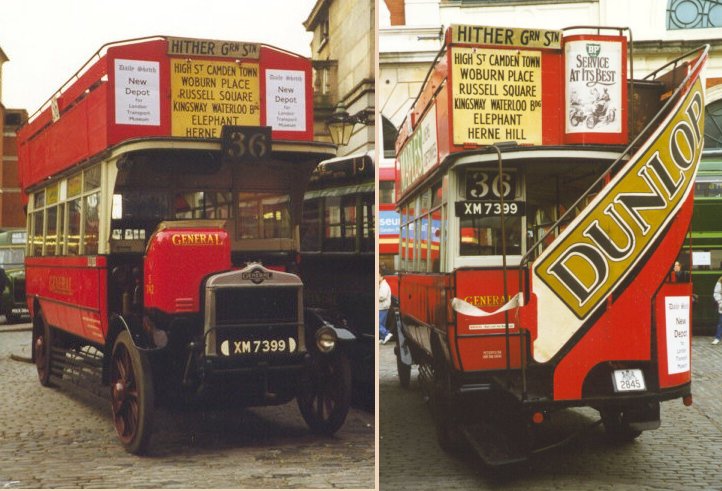
S742 at Covent Garden, en route from Ash Grove to Acton for the LT Reserve Collection, December 1998There was still a place for the lumbering S-types, that were significantly under-powered, but which moved people in large numbers. As they were displaced from their Central trunk routes by the NSs they were available to take over on the long routes to the suburbs, such as the 12, 36 and 21. They enabled the take over of competitors with older types of bus. They operated further out from the centre as the General spread its net over rapidly growing London and bus travel blossomed. They could even be put on as chasers and blockers in the wars with the pirate operators until London routes were regulated by the 1924 London Traffic Act. Many B-types had been owned by the Metropolitan Electric Tramways: the MET. When the rival Metropolitan Bus Company disappeared in 1922 it cleared the way for the MET's buses to wear the METROPOLITAN name. The B-types went, and putative ownership of K-types and S-types in replacemrnt was marked by new fleetnames - on 77 S-types as well as 133 K-types. Once they had been marked it was incumbent (after the new Act) for them to be seen to be operated together, and the S-types were allocated to Camberwell for the 69, Hammersmith for the 88A, Sutton for the 88 and 88B, and Tottenham for the 69. The Sutton buses moved to Merton in February 1926. The 88A suffered a route change in December 1927 involving a bridge too low for S-types. The Hammersmith allocation of 21 S-types was swapped for 21 NS-types, the S-types going back to LGOC ownership. S70 was likewise allocated to the South Metropolitan Tramways, with a SOUTHERN fleetname. S742 on display at Cobham Museum Open Day, alongside contemporaries: K 424, K 502, Chocolate Express XU7498 and D142, April 2003Sleeker single-deckers for National
Note: I have not yet located a rear view that I am sure is of this batch of S-types, so the rear end treatment in the sketches is more than usually conjectural. Other single-deckers were converted to pneumatic tyres in 1928, and survivors received enclosed cabs in 1932.Withdrawal of the red double-deckersAround 700 of General's double-decker S-type remained in service through to 1930, by which time they seemed very much the antiques as bus technology swiftly moved on. Withdrawal began in earnest in January 1931, and all were gone by the end of November. The Regent had landed!More VansIn May 1928 LGOC decided to replace its fleet of Ticket Vans and Catering Vans on B-type chassis with S-types taken from withdrawn buses. There were nine Ticket Vans, and three Catering Vans, which supplies to London Transport kitchens. They were upgraded to pneumatic tyres in 1929 and given glass windscreens in 1932. Four ticket vans were sold in 1933. The rest continued with London Transport, and were renumbered into the Service Vehicle fleet in 1939, as Ticket Vans 11S-15S and Catering Vans 18S to 20S.16S was S384 which was given a tall Chiswick Green van body with open-top for Tree-Pruning. Single-deckers soldier on
They were fitted with pneumatic tyres in 1928. Renowns (LTL class) and Regals (T-class) started to arrive in 1931, displacing many of the S-types. The new buses were much faster as well as bigger and more comfortable. Many S-types went into store, leaving just three at Enfield on the 306B/F (Waltham Cross - Waltham Abbey/Epping Forest) and four at Uxbridge for the 501/503 (Uxbridge - Hounslow/Windsor) by October 1931. But London was still growing, and in 1932 some were relicensed and even given enclosed cabs and windscreens. The 109 (Penge-Chislehurst) acquired eight, five at Elmers End and three at Nunhead. Five revitalised S-types went to Kingston and three to Hounslow. They survived into London Transport ownership. May 1934 saw eight S-types allocated to Harrow Weald to take over route 230 (Northwick Park Stn - North Harrow Stn) from DA-type Darts. They stayed until displaced by Q-types in June 1936. They were the last in service. London TransportThe London Transport Passenger Transport Board (LPTB) took over the General (LGOC) and London General Country Services (LGCS) in 1933. From the General it inherited forty-five single-deckers, which survived mainly until 1935 or 1936. The last eight were on the 230 at Harrow Weald, replaced in June 1936.
Perhaps surprisingly there were also the six East Surrey double-deckers.
Now with pneumatic tyres and additional lower skirts they rumbled about in the Reigate area, mainly on the 410 short-workings. (The main 410 was in the hands of 11 more powerful PS open-toppers). They lasted until October 1934.
PreservationThree S-types are known in preservation:London Transport saved double-decker S742 for its collection. It has passed around various museum locations both in London and elsewhere. I saw it setting off from Covent Garden to the store at Acton in December 1998, braving the West End traffic in the winter twilight, with its single rear light and hand-signals only! Michael Banfield restored S454 after it was found in a breaker's yard in 1965. It turned out that it had started operations at Nunhead, where Charles Banfield, his father had been a driver at the time. Lovingly restored, coincidentally at Nunhead Garage, now owned by the Banfields, it was recently sold at auction by Bonham's, being sold for £281,500! It has been known to take part in the HCVC London-Brighton run, and may now be seen on display. Single decker S433 has been beautifully preserved by Barry Weatherhead. In immaculate condition it can be seen, if you are lucky, at some of the bus rallies. If you see a familiar body gathering dirt and creepers as a shed or hen-house in the corner of a field or barn, let us know!
|
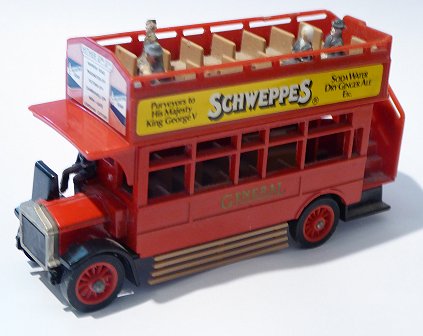 If you have owned a Matchbox Buses of Yesteryear London Bus then you know what the LGOC S-type was like.
It was essentially a stretched K-type (S for stretched?) In 1921 traffic was growing rapidly in the post-war period, and something bigger was needed for the trunk routes across the capital cities (London & Westminster).
The K-type, built from 1919 were a substantial improvement on the B-type, giving 46 seats instead of 34, but the LGOC thought they could do better. In 1920 they built a 56-seater body on a stretched K chassis.
T1 was an experiment, and never went into service.
If you have owned a Matchbox Buses of Yesteryear London Bus then you know what the LGOC S-type was like.
It was essentially a stretched K-type (S for stretched?) In 1921 traffic was growing rapidly in the post-war period, and something bigger was needed for the trunk routes across the capital cities (London & Westminster).
The K-type, built from 1919 were a substantial improvement on the B-type, giving 46 seats instead of 34, but the LGOC thought they could do better. In 1920 they built a 56-seater body on a stretched K chassis.
T1 was an experiment, and never went into service.
 A bigger engine was provided (after the first few), but was still a paltry 5.1 litres, compared to the K's 4.4 litre. So performance did not sparkle! The body was initially a 57 seater, with a 5-seat facing backwards at the front, twenty forward facing seats in 2+2 formation and two sideways facing pairs over the rear wheels. The Police did not approve, especially the rearwards facing front seats. So the downstairs configuration was altered. The 5-seater went, the twenty forward-facing seats were shifted forwards and two three-seater sideways seats completed the layout, giving the 26-seat arrangement downstairs that became the norm. With twenty eight forward facing seats on top, it was a 54-seater.
A bigger engine was provided (after the first few), but was still a paltry 5.1 litres, compared to the K's 4.4 litre. So performance did not sparkle! The body was initially a 57 seater, with a 5-seat facing backwards at the front, twenty forward facing seats in 2+2 formation and two sideways facing pairs over the rear wheels. The Police did not approve, especially the rearwards facing front seats. So the downstairs configuration was altered. The 5-seater went, the twenty forward-facing seats were shifted forwards and two three-seater sideways seats completed the layout, giving the 26-seat arrangement downstairs that became the norm. With twenty eight forward facing seats on top, it was a 54-seater.
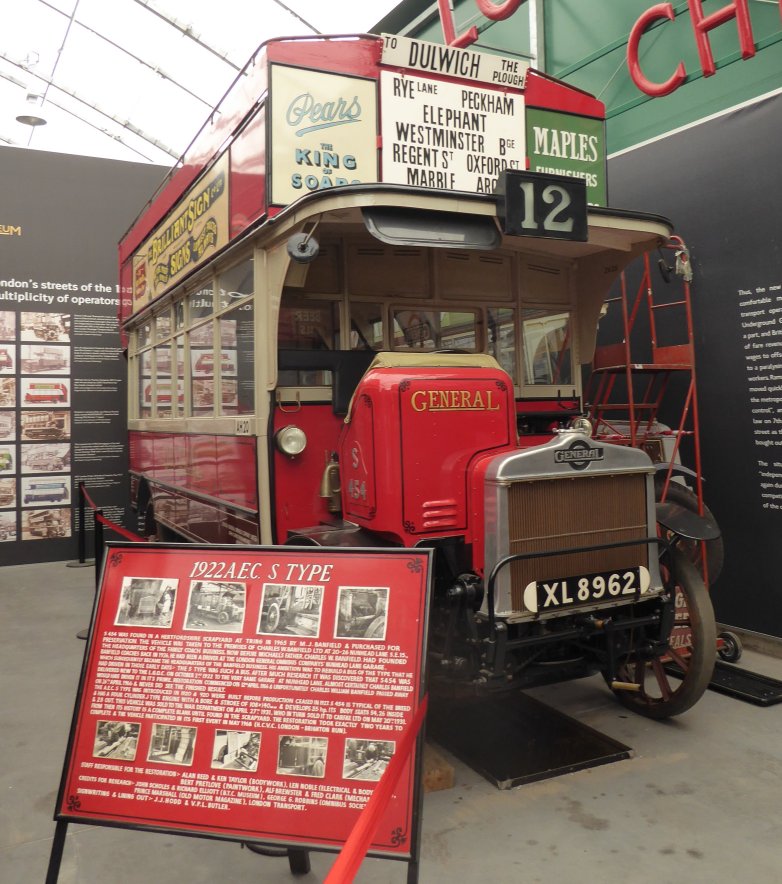
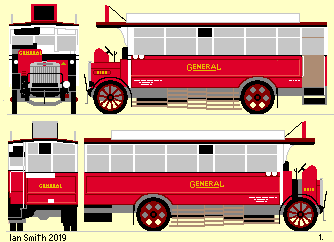 The first of the next main batch of S-types was fitted with a single-decker rear-entrance body seating 32, built by LGOC's North Road works.
S265 was put to work in April 1922 from Kingston, operating on the 115 to Guildford.
The first of the next main batch of S-types was fitted with a single-decker rear-entrance body seating 32, built by LGOC's North Road works.
S265 was put to work in April 1922 from Kingston, operating on the 115 to Guildford.
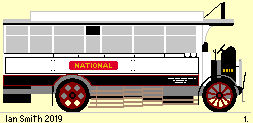 The General also provided ten single-deckers to National at Watford, for use on the N13 (Watford - Barnet): S303,327,331,354,387,388,389,390, plus S265 and S9.
These included eight new buses, plus the prototype single-decker (S265), and S9,
which was an early bus rebodied with a new single-decker body at overhaul.
They wore National's mainly-white livery.
The General also provided ten single-deckers to National at Watford, for use on the N13 (Watford - Barnet): S303,327,331,354,387,388,389,390, plus S265 and S9.
These included eight new buses, plus the prototype single-decker (S265), and S9,
which was an early bus rebodied with a new single-decker body at overhaul.
They wore National's mainly-white livery.
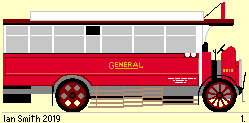 September 1922 saw nine single decker S-types replace the single-decker B-types on the Blackwall Tunnel 108 route (Poplar - Blackwall Tunnel - Eltham). The B-types were back on the 108 in November,
when the S-types were all switched to Dalston to operate a new 108A (Clapton - Blackwall Tunnel - Lewisham).
September 1922 saw nine single decker S-types replace the single-decker B-types on the Blackwall Tunnel 108 route (Poplar - Blackwall Tunnel - Eltham). The B-types were back on the 108 in November,
when the S-types were all switched to Dalston to operate a new 108A (Clapton - Blackwall Tunnel - Lewisham).
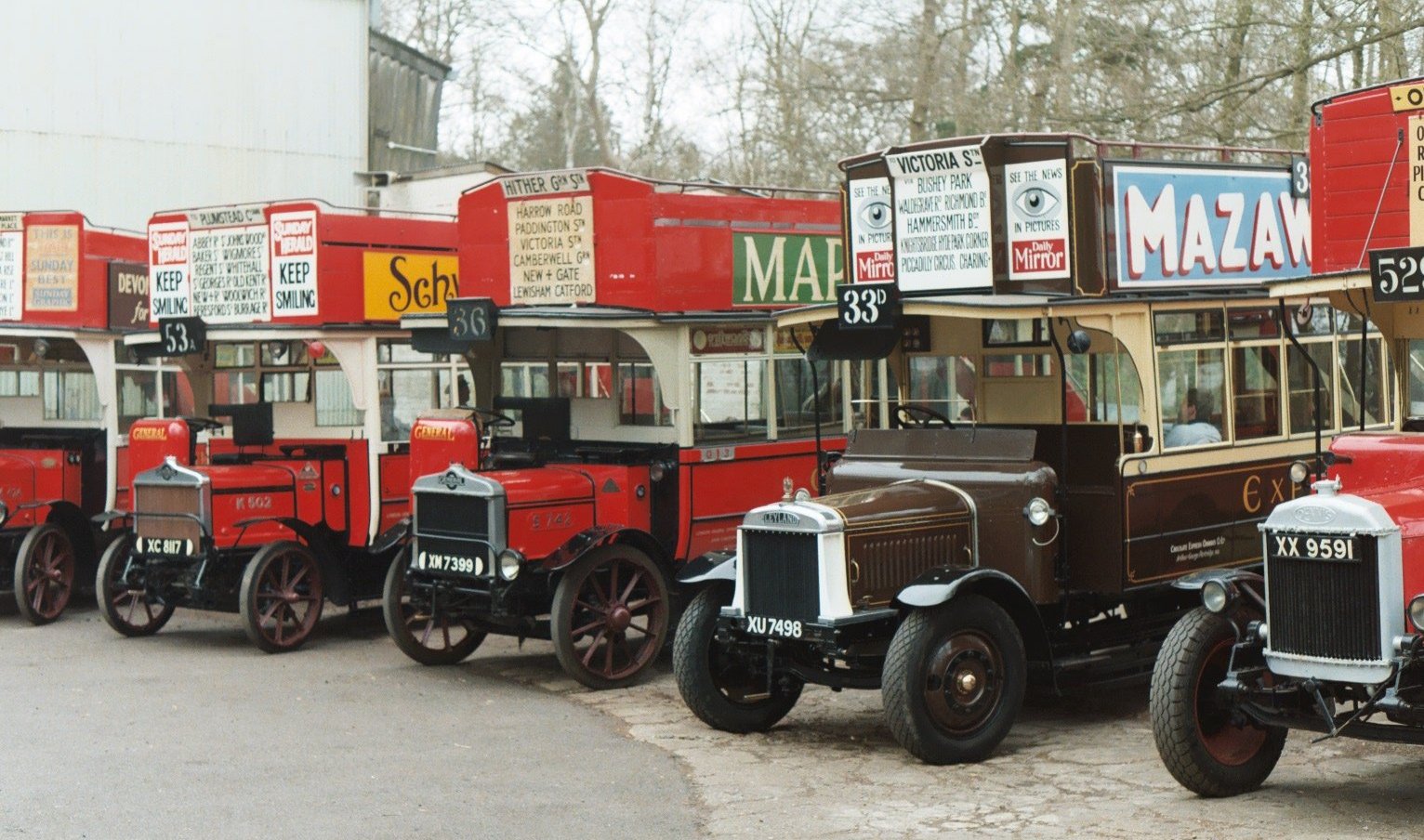
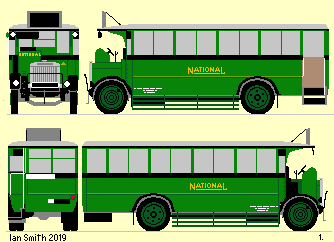 With no NS-style single-deckers in the offing, another thirteen S-types were produced in early 1927.
These had a modernised style of bodywork, much more sleek and modern-looking, like the K-type single-deckers. They also had pneumatic tyres. These, as well as giving a more comfortable ride,
and allowing 20mph instead of 12mph, were subject to much lower road tax (£72 down to £57/12/0).
S915-927 were sent to Watford for the 306 and 311. They survived to be taken over by London Country Bus services in 1932, and then London Transport in 1933, before giving way to Q-types sometime in 1934.
With no NS-style single-deckers in the offing, another thirteen S-types were produced in early 1927.
These had a modernised style of bodywork, much more sleek and modern-looking, like the K-type single-deckers. They also had pneumatic tyres. These, as well as giving a more comfortable ride,
and allowing 20mph instead of 12mph, were subject to much lower road tax (£72 down to £57/12/0).
S915-927 were sent to Watford for the 306 and 311. They survived to be taken over by London Country Bus services in 1932, and then London Transport in 1933, before giving way to Q-types sometime in 1934.
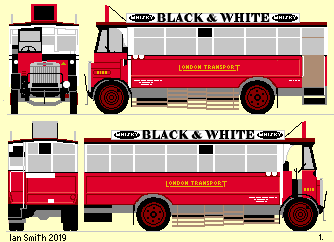 The Central Area still had fifty single-decker S-types. The sizeable batch on the Blackwall Tunnel routes were replaced by double-decker Tunnel NS-types at the end of October 1927. Athol Street's ten S-types were dispersed to other garages. Some went to Nunhead for use on the 109 (Penge - Bromley - Chislehurst),
where their lack of power on this very unsuitable and hilly route was very apparent!
The Central Area still had fifty single-decker S-types. The sizeable batch on the Blackwall Tunnel routes were replaced by double-decker Tunnel NS-types at the end of October 1927. Athol Street's ten S-types were dispersed to other garages. Some went to Nunhead for use on the 109 (Penge - Bromley - Chislehurst),
where their lack of power on this very unsuitable and hilly route was very apparent!
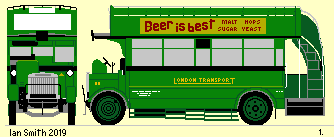 From LGCS it took on the final batch of single-deckers that had been new for National in 1927. They succumbed to Q-types in 1934.
From LGCS it took on the final batch of single-deckers that had been new for National in 1927. They succumbed to Q-types in 1934.
 Bus Stop
Bus Stop S text.
S text. bus histories
bus histories PS buses
PS buses